Dame Paula Rego is wearing a red cardigan and a necklace of brightly coloured mice. Sitting in her studio surrounded by a strange population of life-size “dollies”, discombobulated animals, disembodied faces and racks of costumes, she greets her son, film-maker Nick Willing. He has just completed a documentary about her, which will be aired on the BBC next week.
This deeply intimate film ranges across the life and art of the Portuguese-born artist, whose work is bracketed with Lucian Freud, Frank Auerbach and David Hockney. She talks about sex and abortions (she’s had several), her complex relationship with her husband, artist Victor Willing, giving birth (“like a great big screw”) and affairs (by both partners), politics, bankruptcy, family and depression. Of all these, it is only depression she is reticent about. It’s the only one that makes her feel “ashamed”.
In 2007, Rego had a particularly desperate bout of depression, which her son says nearly killed her, before she “drew her way out of it”. She created 12 large pastels of a woman – isolated, fearful, paralysed, constricted – then locked them away in a drawer. “She had put the depression into them,” says Willing, “and was afraid it could come out again.”
He didn’t even know the images existed until, shortly after her 80th birthday, “My mother started telling me stories I hadn’t heard before, so I asked if I could make a film about her. Even a few years ago, she would have told me to fuck off – but to my amazement, she agreed.” His sister suggested he ask about depression, and the result was Rego unlocking the depression pictures on camera – and their public display in an exhibition that opens in London next week.
Rego speaks quietly and deliberately, occasionally tilting her head like a child, gauging the effect of her words. “Some of the pictures I didn’t remember doing,” she says, “but I’ve been depressed so often.” Today, Rego can view the images more comfortably: “Now they’re pictures, it’s all right”. This is a theme that runs through her life and work: traumas are turned into art; difficult emotions are worked through in images. Sometimes she uses dark fairytales or children’s stories as a starting point and, she says, they turn into something more personal as she works. At other times, she is painfully direct.
Willing has got up from his chair and is standing in front of some drawings pinned to the wall. They show a bruised and battered face. “Mum fell just after Christmas,” he says. “She looked like Mike Tyson, so she rushed here and did five self-portraits – her first.” Rego looks up at them, a smile across her healed cheeks. She normally refuses to depict her face (“embarrassing”). But she says: “I loved doing those. I didn’t like the fall, and the ambulance was the worst, but the self-portraits I liked doing. I had something to show.”
Rego features in many of her own pictures, including the depression series, but her role is always taken by Lila, who has been her assistant and model for the last 30 years: “Lila is me,” Rego says. Willing was surprised at how he reacted to the unveiling of the depression pastels. He was expecting to be shocked, to feel sorry for his mother. “But I didn’t. I didn’t see her at all. I saw depression, as I or anyone else suffers it. The art was already working.”
This recognition is what art is all about, he says, echoing his father’s words to him when he was eight. Willing tells me he was angry his parents were leaving him with his grandparents in Portugal, yet again, while they returned to their studio in Camden Town, London. “I asked my father what was so bloody important about art that it should take them away? I understood about doctors and firemen – but artists? My father said, as if he were explaining how the Earth goes round the sun, that an artist is like an explorer who goes to worlds where no one has ever been and brings back a picture. And although we’ve never seen it before, we all recognise it. Even then, that took my breath away and I thought, ‘That is the most important thing anyone can do.’”
That didn’t stop him from feeling cut out of his parents’ lives, however, and the recognition afforded by the depression pictures also brought a strange – if belated – relief. Even on the rare occasions in his childhood when his mother was there, he says, “She wasn’t really present. She was beautiful and glamorous and she would sometimes sit and draw with me – her idea of real closeness. But even then she was often withdrawn, drugged or drunk, closed to me.” Only now, taking in the depression pictures in his 50s, “protected” by his camera, did he finally understand “that this was not my fault. It wasn’t because I was a bad drawer or a bad person. It was depression and her attempts to hide it.”
There were other reasons, too: “To be a great artist, her emotional energy had to go into her work,” he says, which meant there wasn’t much left for her children, especially as there was another call on her emotions: “She was deeply in love and lust with my father.” Rego is now slightly embarrassed about her unflinching description on camera of her first meeting with Victor. They were at a party and he (a married man) led her into an empty room and said simply, “Take down your knickers”, and she did.
Her son wasn’t shocked by this story: “It was family folklore, and when my mother told us [as children] it sounded romantic. When she told it for the film – adding that she was a virgin, there was blood everywhere and he didn’t even get her a cab home – I heard for the first time that it was closer to rape. It was horrible.”
It was also, mother and son agree, the start of the most important relationship of her life – and art. “She always did whatever he wanted,” Willing says. “He never told her he loved her. He shagged her best friend, but he was the smartest man I’ve ever met, and he fed her in all sorts of ways.” And the letter he left her when he died in 1988, a letter not spoken about before, “kept that feeding going”. It said: “Trust yourself and you will be your own best friend.”
Willing repeats the words “will be” and says: “He knew she wasn’t. She carried that letter next to her heart for 20 years. It gave her strength.” Some of her most disturbing – and most successful – work was done at this time. “The Dog Women, the abortion pictures, and Target – a woman helping her husband to shoot her! – are all about being with him.” Their life together, his early departure from it and that letter were central to the success that came to her soon after his death and turned her into one of the UK’s, as well as Portugal’s, most admired contemporary artists.
Willing believes that his ability to get his mother to talk so freely is partly down to his resemblance to Victor. “Nick looks very like his father,” Rego agrees, glancing adoringly across at him, “but he’s not like him, thank God. Nick’s a normal boy, chap, man.” Did she feel making the film brought them closer? “We were already close,” she says, telling me how they travelled across Europe together to see Bruegel’s Fall of Icarus when Willing was 14, as if this proves their closeness beyond doubt.
Unrepentantly, however, she admits that the children were kept well away from her work. Even in the summer, the only time the family lived together, in a “magical” summer house in a Portuguese fishing village, “we didn’t let them into the studio when they were banging on the door”.
“Never,” confirms Willing. “You could knock on that door with a broken leg and they wouldn’t open it.” Only once did the studio door open to him as a boy: “I had done a drawing of two men fighting. It was quite expressionist. I pushed it under the studio door. The door opened and my mother was holding the picture. She asked me what it was about. I made up a story and she listened intently. Later I discovered she had cut it up and put it in one of her pictures and I thought, ‘Fuck, the power of art – it really gets to people. It can even get to my mother!’”
The film Willing has made is perhaps his adult version of the drawing under the studio door. Certainly, it has connected him with his mother and Rego is delighted with it. Willing, however, is a little afraid. “I made the film to try to understand and get close to my mum, but I’ve trespassed into her world, her work. I am not afraid of damaging her, but I am terrified of having a detrimental effect on the thing that matters most to her in the world: her art.”
Rego is unconcerned. She lets life happen to her, then deals with the consequences in art. She rarely takes control, Willing agrees, “except in secret, like her affairs – and of course in her work”. I look again at Rego’s necklace. She’s a bit like one of those brightly coloured mice. “My grand-daughter made this for me,” she says, and squeezes one of the mice. It lets out a loud squeak and she giggles like a child.






No hay comentarios:
Publicar un comentario